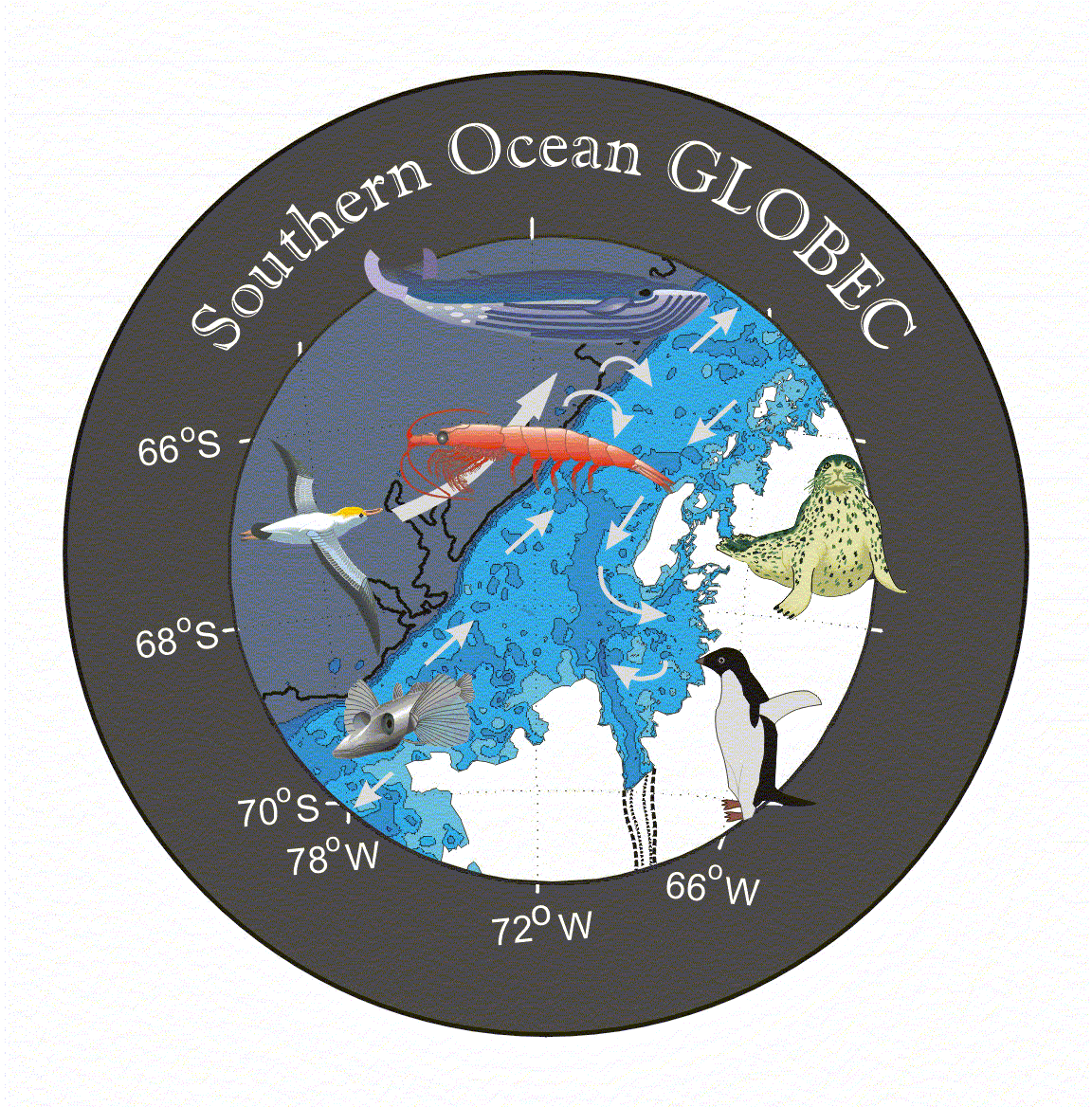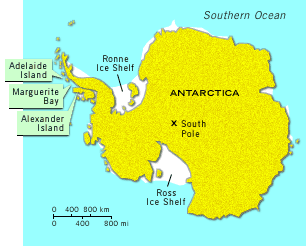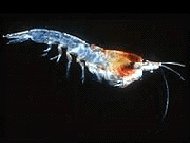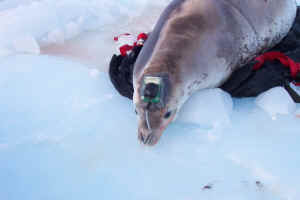Southern Ocean Program Report
 A very productive first field season in the Southern Ocean recently came to a close. Preliminary results, which range from new
bathymetry to new views of cetacean ecology are very encouraging. Eileen Hofmann(ODU) and Bob Beardsley(WHOI) presented the summary for
the Southern Ocean Program.
A very productive first field season in the Southern Ocean recently came to a close. Preliminary results, which range from new
bathymetry to new views of cetacean ecology are very encouraging. Eileen Hofmann(ODU) and Bob Beardsley(WHOI) presented the summary for
the Southern Ocean Program.
Eileen presented an abbreviated timeline, noting that the program had begun in 1991. US GLOBEC Cruises for 2002 are scheduled
for 9 April - 21 May and 31 July ñ 19 September. This places the austral Fall cruise earlier and the winter cruise later than in 2001.
Chief Scientists will be Peter Wiebe and Dan Costa. A February mooring cruise is also scheduled. International cruises are planned by
the UK, Germany, Australia and Korea. Tentative GLOBEC or GLOBEC-like cruises are planned by Japan, Spain and Peru in 2002 for areas north of the US GLOBEC study area
of Marguerite Bay. These activities may provide important information comparable to that collected in US GLOBEC.
 Five cruises in the Marguerite Bay region formed the core of the 2001 field effort in SO GLOBEC.
These included a June mooring cruise
in which a number of cetaceans were encountered. Tissue samples were collected for biopsy. Whale
sightings were unexpected in this area in June and represent a new aspect of cetacean ecology. ADCP, BIOMAPER and net sample data were
also collected from the Palmer and yielded interesting insights. All cruise reports should be completed and available within two
months. One is available currently and two more will printed shortly. Chief Scientists were acknowledged for their excellent efforts in
pulling the cruise reports together.
Five cruises in the Marguerite Bay region formed the core of the 2001 field effort in SO GLOBEC.
These included a June mooring cruise
in which a number of cetaceans were encountered. Tissue samples were collected for biopsy. Whale
sightings were unexpected in this area in June and represent a new aspect of cetacean ecology. ADCP, BIOMAPER and net sample data were
also collected from the Palmer and yielded interesting insights. All cruise reports should be completed and available within two
months. One is available currently and two more will printed shortly. Chief Scientists were acknowledged for their excellent efforts in
pulling the cruise reports together.
Onboard the R/V Nathaniel B. Palmer
were National Geographic photographer Mark Christmas and NSF Science Writer Aparna Sreenivason.
National Geographic has created the SeaLab website to cover the cruise. USA Today featured some of Aparna's work.
 BIOMAPER II and net sampling indicate that adult krill may migrate inshore during the winter. Adult krill
were found deep in the water column, possibly in holes or depressions. It is speculated that they are moving into
the shelter of fjords along the coast to overwinter. Juvenile krill were very abundant during 2001 and were found broadly distributed in the Bay and located in the
upper part of the water column. This is apparently a large year class. Interestingly, there is little evidence of intermediate-sized krill. This is hypothesized to be the result of
recruitment failures during the last two years. Gear avoidance by krill was strongly suggested when researchers noticed krill avoiding the area
around a CTD cast. Preliminary study of the problem took place during the cruise. Krill catch increased when the MOCNESS was equipped with
a strobe light. The possibility of following the large 2001 year class of krill in the LTER cruises was raised.
Unfortunately, this seems unlikely because the LTER cruises may not overlap with krill distributions.
A question was raised as to whether krill occur in a number of discrete subpopulations or in a single large population that
occurs all around the continent. The working hypothesis is that krill occur in subpopulations. The physical oceanographic processes
observed during the US GLOBEC cruises, as well as in previous studies, make exchange between subpopulations very likely. There is currently no genetic evidence to address the
question.
BIOMAPER II and net sampling indicate that adult krill may migrate inshore during the winter. Adult krill
were found deep in the water column, possibly in holes or depressions. It is speculated that they are moving into
the shelter of fjords along the coast to overwinter. Juvenile krill were very abundant during 2001 and were found broadly distributed in the Bay and located in the
upper part of the water column. This is apparently a large year class. Interestingly, there is little evidence of intermediate-sized krill. This is hypothesized to be the result of
recruitment failures during the last two years. Gear avoidance by krill was strongly suggested when researchers noticed krill avoiding the area
around a CTD cast. Preliminary study of the problem took place during the cruise. Krill catch increased when the MOCNESS was equipped with
a strobe light. The possibility of following the large 2001 year class of krill in the LTER cruises was raised.
Unfortunately, this seems unlikely because the LTER cruises may not overlap with krill distributions.
A question was raised as to whether krill occur in a number of discrete subpopulations or in a single large population that
occurs all around the continent. The working hypothesis is that krill occur in subpopulations. The physical oceanographic processes
observed during the US GLOBEC cruises, as well as in previous studies, make exchange between subpopulations very likely. There is currently no genetic evidence to address the
question.
Bioenergetic models for krill have been developed and are available to the community. These models were constructed such that metabolic rates
decline during the winter. This was done in an effort to have the model better fit observational data. Jose Torres and associates conducted a
number of dives under the ice and in open water during this field season to gather physiological rate
information. These physiological data support the
modeling assumption and it is believed that the decline is related to seasonally decreasing photoperiod.
There also seemed to be significant changes in community structure with season (TWO OVERHEADS). Sea ice is believed to be an important substrate for biological activity and its extent may be limited in the Bay due to a possible interaction between shelf topography and the Antarctic Circumpolar Current (ACC). The ACC may pump warm deep
water up onto the shelf via the Marguerite Trough (FIGURE?) leading toward the Bay. This warm water appears on maps of temperature at depths
greater than 200 meters.
Scott Gallager's
Video Plankton Recorder was used extensively to examine the microzooplankton community.
Mesodinium sp. ciliates were common and occurred along frontal regions and in lower salinity water in the surface mixed
layer. A lack of phytoplankton in the water column is speculated to be caused by microzooplankton grazing.
 Dan Costa
and colleagues have satellite tagged approximately 12 crabeater seals in 2001(AVS PLOT of XYZ tracks). These seals appear to be using the ACC front
as well as areas where deep water is being pumped onto the shelf. Crabeater seals also occur frequently along the axis of the canyon.
Dan Costa
and colleagues have satellite tagged approximately 12 crabeater seals in 2001(AVS PLOT of XYZ tracks). These seals appear to be using the ACC front
as well as areas where deep water is being pumped onto the shelf. Crabeater seals also occur frequently along the axis of the canyon.
Adelie penguins, a top predator on krill, were tagged with satellite transmitters. These penguins have been tracked over a 3-4 month time frame. Tracking time is limited by batteries and the frequency of transmission. Penguins were tagged from the peninsula to Marguerite Bay and have moved
from Marguerite Bay to the South Shetland Islands. This distance is quite a bit further than anticipated. Bill Frazier's group pumped
penguin stomachs for diet analysis.
The International Whaling Commission
made a significant contribution
to this research and observed a number of humpback and minkie whales in frontal areas and along the edges of the ACC. Interestingly, no minkie vocalizations were
collected during these SO cruises. The minkie population occurring off Seattle are not known to vocalize either and a genetic link between these groups is a
possibility for further study.
Bob Beardsley and Dick Limeburner presented the Southern Ocean drifter release results. The research made use of satellite-tracked drifters (WOCE SVP
ARGOS Drifters with a 7m holey sock drogued at 15m), isobaric floats and moorings. This study was intended to address a null hypothesis that a cyclonic gyre
contributes to the retention of populations within the study region.
Animations (available through the link above) made from drifter track data show a large degree of coherence in drifter movement in
the study area. The source of this coherence is currently unknown. A simple Ekman response to the wind field would result in
velocities on the order of 1.6 cm/s which are far too low to explain the observations. Remote wind forcing has not been ruled out. A study of
Lagrangian time and space scales indicates that drifters move coherently over about 2.9 days and 20-30 kms. The inertial period is
12.99 hours; close to the 12.42 M2 tide.
Circulation patterns suggest some topographic control and a question arose over the persistence of eddies in the study area.
Currently no one knows. The steep bathymetry in the area is poorly measured in most areas. Significant differences exist between
published charts and seabeam field observation. This lack of bathymetric information does have implications for hydrodynamic modeling.
However, comparisons between circulation model output and ADCP data is good and the program plans to have the circulation model onboard during the
2002 cruises. It is hoped that conditions observed in the first cruise could be used to initialize the model for use in the second
cruise.
Eileen noted that drifter tracks presented by Beardsley were similar to others she had seen from the RACER program centered near the
South Shetlands Islands. The similarity may allow for some comparisons between RACER and SO GLOBEC.
Winds and heat flux have been identified as important drivers in circulation. The research vessels have been used as meteorological stations
to observe the change in heat flux from the summer into winter. Solar input in the summer is large, but drops off as winter
approaches. One may expect a large impact on sensible and latent heat flux under these conditions, but this is not observed. The
temperature difference between air and sea is low and the air is humid unless it originates over land. This results in longwave
radiation being the biggest term in the heat budget in the region.
NSF funded automated weather stations have been installed on two islands in the middle of Marguerite Bay and will provide wind,
temperature, relative humidity and pressure data to Wisconsin. This is a significant improvement over the present situation. The nearest weather station is on the ABELARE ISLAND and is influenced
by its location on land.
Due to current krill population characteristics collecting climatological data in the area is considered advisable. It isn't known if 2001 was a typical year. Bob Beardsley suggested that some long term data may be available. Germany seems to have a well funded
presence and may have long time series. Scatterometer data is being collected and ACC data is available. A time series is also available from the RATHER station, but a fire destroyed the
lab facility there. However, the station is operational and no significant interruption in routine collection data is anticipated.
The topic of a synthesis phase for the Southern Ocean Program was brought to the table. The program will require a distinct synthesis phase
with adequate directed funding. A great deal of new information is being collected and significant post-cruise analysis is necessary. Currently
there is no such funding available. Strong, active support from the SSC for such an effort will be necessary if we are to access funding possibilities
within the Office of Polar Programs.
Bernie Lettau stated that Polar Programs has difficulty participating in 'global' programs. Funds are
typically carved out of the working budget. The task of allocating funds for SO synthesis would be easier
with a strong statement from the SSC. Eileen and Mike agreed to produce such a letter. (Recent information
looks promising for a synthesis phase.)
Eileen, Peter, Jose and Dan are convening a dedicated Southern Ocean session at the AGU/ASLO Ocean Sciences Meeting this year. All Program PIs are encouraged to attend.
 A very productive first field season in the Southern Ocean recently came to a close. Preliminary results, which range from new
bathymetry to new views of cetacean ecology are very encouraging. Eileen Hofmann(ODU) and Bob Beardsley(WHOI) presented the summary for
the Southern Ocean Program.
A very productive first field season in the Southern Ocean recently came to a close. Preliminary results, which range from new
bathymetry to new views of cetacean ecology are very encouraging. Eileen Hofmann(ODU) and Bob Beardsley(WHOI) presented the summary for
the Southern Ocean Program.

